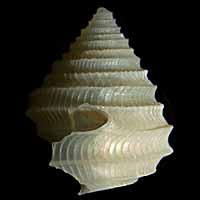|
< Previous family introduction |
|
|||||
 |
Family Seguenziidae
|
|||||
|
The Seguenziidae is a family of minute to small deep-water molluscs with elaborate shell sculpture, particularly in the formation of the aperture. They occur throughout the Pacific, Atlantic, Indian and Antarctic Oceans, where they are most common below 1000 m depth, and rarely encountered shallower than 300 m. There are less than 200 species known from the family, the majority having been described from deep sea sampling in the last few decades. Seguenziid shells are thin, with an underlying nacreous layer, and often have strong, raised, spiral keels and delicate axial ribs, producing sculpture characteristic of the family. There are elaborate modifications around the aperture, resulting from modification of the mantle tissue (that secretes the shell) to also form semi-tubular lobes to channel water flow through the mantle cavity. There may be two major and two minor channels. The mantle modifications are reflected in the shape of the shell, with deep indentations, or sinuses, in the outer lip. Regardless, the overall shape of the shells included in the family varies from trochiform to tall conical to low conical, a variation encompassed by the few species of the NSW fauna. Only three species of the family are recognised from NSW waters, one of which appears to be undescribed. They are all represented by small numbers of specimens (5-20 per species) in the Australian Museum collection. This is in contrast to the extensive fauna reported from deep water off New Zealand and New Caledonia by Marshall (1983, 1988, 1991) and reflects the lack of sampling with the appropriate gear for retrieving small and minute shells. Family Reference There is no consolidated reference to the species of this family. Coverage All the identifiable species from NSW are detailed here. In addition to these, the Australian Museum holds a few specimens each of several unidentified or undescribed species. Identification Notes Seguenziid shells are minute to small, from depths greater than 300 m. There is an underlying nacreous layer, producing a lustrous appearance. There is at least one strong spiral keel, and sinuses in the aperture. In the simpler shells there are shallow sinuses below the suture and on the base, but in more elaborate shells the sinuses are deep with flared surrounds. In some genera there is elaborate axial sculpture, but others are smooth. An umbilicus may or may not be present.
|